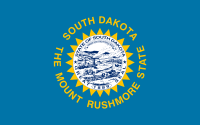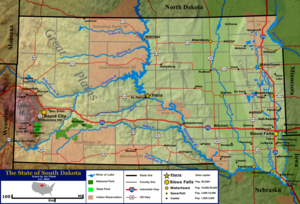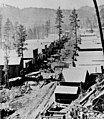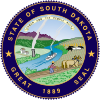Portal:South Dakota
The South Dakota Portal South Dakota (/dəˈkoʊtə/ də-KOH-tə; Sioux: Dakȟóta itókaga, pronounced [daˈkˣota iˈtokaga]) is a landlocked state in the North Central region of the United States. It is also part of the Great Plains. South Dakota is named after the Dakota Sioux tribe, which comprises a large portion of the population with nine reservations currently in the state and has historically dominated the territory. South Dakota is the 17th largest by area, but the 5th least populous, and the 5th least densely populated of the 50 United States. Pierre is the state capital, and Sioux Falls, with a population of about 213,900, is South Dakota's most populous city. The state is bisected by the Missouri River, dividing South Dakota into two geographically and socially distinct halves, known to residents as "East River" and "West River". South Dakota is bordered by North Dakota to the north, Minnesota to the east, Iowa to the southeast, Nebraska to the south, Wyoming to the west, and Montana to the northwest. Humans have inhabited the area for several millennia, with the Sioux becoming dominant by the early 19th century. In the late 19th century, European-American settlement intensified after a gold rush in the Black Hills and the construction of railroads from the east. Encroaching miners and settlers triggered a number of Indian wars, ending with the Wounded Knee Massacre in 1890. As the southern part of the former Dakota Territory, South Dakota became a state on November 2, 1889, simultaneously with North Dakota. They are the 39th and 40th states admitted to the union; President Benjamin Harrison shuffled the statehood papers before signing them so that no one could tell which became a state first. Key events in the 20th century included the Dust Bowl and Great Depression, increased federal spending during the 1940s and 1950s for agriculture and defense, and an industrialization of agriculture that has reduced family farming. Eastern South Dakota is home to most of the state's population, and the area's fertile soil is used to grow a variety of crops. West of the Missouri River, ranching is the predominant agricultural activity, and the economy is more dependent on tourism and defense spending. Most of the Native American reservations are in West River. The Black Hills, a group of low pine-covered mountains sacred to the Sioux, is in the southwest part of the state. Mount Rushmore, a major tourist destination, is there. South Dakota has a temperate continental climate, with four distinct seasons and precipitation ranging from moderate in the east to semi-arid in the west. The state's ecology features species typical of a North American grassland biome. (Full article...) Selected article -The COVID-19 pandemic in South Dakota is an ongoing viral pandemic of coronavirus disease 2019 (COVID-19), a novel infectious disease caused by severe acute respiratory syndrome coronavirus 2 (SARS-CoV-2). The state of South Dakota reported its first four cases and one death from COVID-19 on March 10, 2020. On June 15, 2021, South Dakota public health authorities reported 25 new cases of COVID-19, bringing the state's cumulative total to 124,377 cases. The state's COVID-19 death toll is 2,026, with no new deaths reported over the previous 24 hours. The state ranks 9th in deaths per capita among U.S. states (with New York City counted separately), and 3rd in cases per-capita, behind only North Dakota and Rhode Island (14,042 cases per 100,000). The state did not utilize mitigation strategies such as stay-at-home orders or mandating face masks in public spaces, with Governor of South Dakota Kristi Noem citing a desire to respect residents' personal freedoms and responsibilities, and disputing studies demonstrating their efficacy. In October 2020, amid record cases and hospitalizations in the state, Noem told her Legislature that she had received praise from a "prominent national reporter" for not imposing a lockdown. The absence of state-wide action has faced criticism from local officials, and prompted health orders to be issued at the municipal level instead of statewide. (Full article...)CategoriesRelated portalsEntries here consist of Good and Featured articles, which meet a core set of high editorial standards.
 South Dakota is a state located in the north-central United States. It is usually considered to be in the Midwestern region of the country. The state can generally be divided into three geographic regions: eastern South Dakota, western South Dakota, and the Black Hills. Eastern South Dakota is lower in elevation and higher in precipitation than the western part of the state, and the Black Hills are a low, isolated mountain group in the southwestern corner of the state. Smaller sub-regions in the state include the Coteau des Prairies, Missouri Coteau, James River Valley, and the Dissected Till Plains. Geologic formations in South Dakota range in age from two billion-year-old Precambrian granite in the Black Hills to glacial till deposited over the last few million years. South Dakota is the 17th-largest state in the country. South Dakota has a humid continental climate in the east and the Black Hills, and a semi-arid climate in the west outside of the Black Hills, featuring four very distinct seasons, and the ecology of the state features plant and animal species typical of a North American temperate grassland biome. A number of areas under the protection of the federal or state government, such as Badlands National Park, Wind Cave National Park, and Custer State Park, are located in the state. (Full article...)General images -The following are images from various South Dakota-related articles on Wikipedia.
Did you know -
TopicsLargest citiesCities in South Dakota, with their populations (as of July 1, 2020, as enumerated by the 2020 United States census):
WikiProjectsNew articlesThis list was generated from these rules. Questions and feedback are always welcome! The search is being run daily with the most recent ~14 days of results. Note: Some articles may not be relevant to this project.
Rules | Match log | Results page (for watching) | Last updated: 2024-08-23 22:28 (UTC) Note: The list display can now be customized by each user. See List display personalization for details.
Associated WikimediaThe following Wikimedia Foundation sister projects provide more on this subject:
Sources
|




















